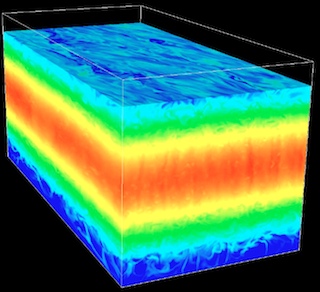
The magnetorotational instability (MRI), also known as the Balbus-Hawley instability, is thought responsible for the initiation of turbulence and angular momentum transport in astrophysical disks. In work led by Jake Simon, we are using the Athena MHD code to study the non-linear evolution of the MRI in local and global geometry. We are interested both in the limit of ideal MHD, appropriate for well-ionized disks around black holes and compact objects, and the non-ideal MHD case relevant to protoplanetary disks where the effects of Ohmic and ambipolar diffusion are important.
The movie shows the evolution of density and magnetic fields from a large shearing box simulation of the MRI. Details of the simulations are discussed in Turbulent linewidths in protoplanetary disks (Jacob B. Simon, Philip J. Armitage and Kris Beckwith, ApJ, 2011). These simulations are part of a set that now includes large, high-resolution runs in ideal MHD (Emergent mesoscale phenomena in magnetized accretion disc turbulence) and calculations of protoplanetary disks that incorporate ambipolar diffusion (Turbulence in the outer regions of protoplanetary disks).